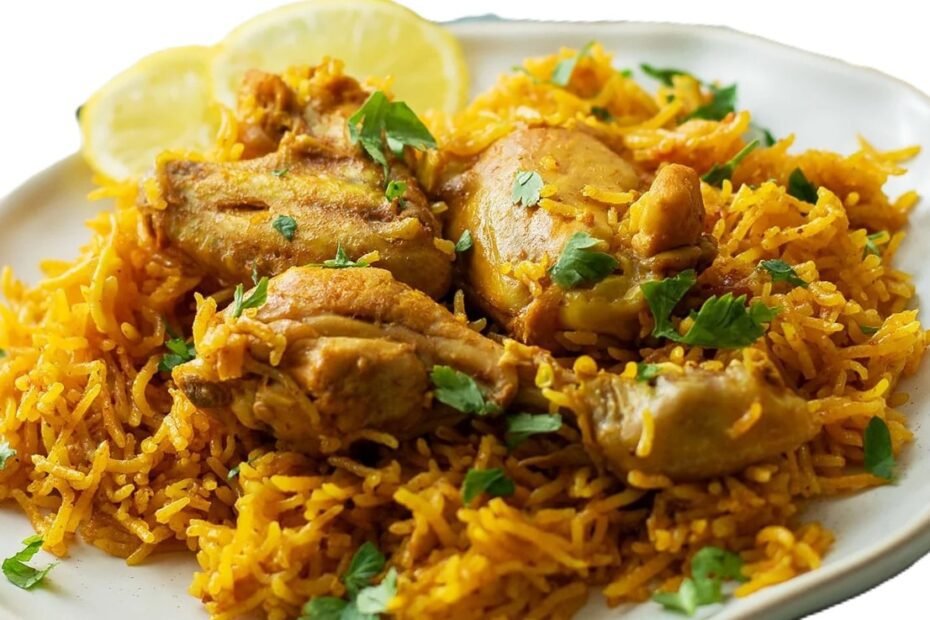When I first boarded my flight from Delhi to Riyadh, I had very little idea of what awaited me on my plate in Saudi Arabia. I had heard of the deserts, the holy cities, and the grandeur of the Kingdom, but what intrigued me most was its food culture. As an Indian woman who has always loved cooking and eating, my heart was set on exploring the kitchens and markets as much as the mosques and palaces. And soon, one dish began to stand out everywhere I went—Kabsa, a fragrant rice and meat preparation that locals often call the pride of Saudi dining tables.
First Encounter with Kabsa
My very first evening in Riyadh, a local family I befriended through a cultural tour invited me to dinner. As I entered their home, I was welcomed with Arabic coffee (qahwa) and dates, a gesture of deep hospitality. Then came the main dish—a huge platter of rice and tender lamb, spiced beautifully and garnished with roasted nuts and raisins. This was Kabsa.
The aroma reminded me faintly of biryani back home, but the flavour was distinct—less oily, more earthy, and perfumed with a blend of spices that felt exotic yet comforting. As everyone sat around the big plate and ate with their hands, I realised Kabsa was not just food—it was an experience of sharing, togetherness, and warmth.
My Food Journey Across Saudi Arabia
Travelling through the Kingdom, I soon discovered that Kabsa was only one chapter in a long story of Saudi and Arab food traditions.
- In Jeddah, by the Red Sea, I tried Sayadiya—a spiced rice dish with fish. The caramelised onions in the rice gave it a sweetness that balanced the fish perfectly.
- In Makkah, during iftar in Ramadan, I tasted Harees, a comforting wheat and meat porridge, which reminded me of our Indian haleem but lighter in texture.
- In Medina, the street stalls served me Shawarma, juicy grilled meat wrapped in flatbread with garlic sauce and pickles. It was quick, filling, and addictive.
- In Dammam, I had Mutabbaq, a stuffed savoury pancake filled with minced meat and onions, which instantly reminded me of Mughlai parathas from Kolkata.
- In Najran, I tasted Jareesh, cracked wheat cooked with chicken and spiced in a mild way. It felt homely, something like khichdi, but with an Arabian character.
- And of course, every city offered me countless cups of Arabic coffee flavoured with cardamom, always accompanied by dates that melted in the mouth.
Each meal made me realise how diverse Saudi cuisine is—sometimes robust and meaty, sometimes simple and soulful, but always prepared with generosity.
Step by Step Recipe for Kabsa
Once back in my hotel in Riyadh, I could not resist asking the chef for a Kabsa recipe. He kindly explained it to me in detail, and later I tried it myself. Here is the version I carried back to India and adapted to my kitchen.
Ingredients
- Basmati rice – 2 cups
- Lamb, chicken, or beef – 500 g (cut into medium pieces)
- Onions – 2 large, thinly sliced
- Tomatoes – 2 medium, chopped
- Garlic – 5 cloves, crushed
- Ginger – 1 inch, grated
- Carrots – 1 large, cut into matchsticks
- Kabsa spice mix (or you can make your own with equal parts black pepper, cloves, cinnamon, cardamom, bay leaf, nutmeg, dried lime powder if available)
- Red chilli powder – 1 tsp (optional, for Indian taste)
- Salt – as required
- Vegetable oil or ghee – 3 tbsp
- Raisins – 2 tbsp
- Almonds or cashews – 2 tbsp, roasted
Method
- Wash the rice and soak for 30 minutes. Drain before cooking.
- Heat oil or ghee in a heavy pot. Fry the sliced onions until golden brown.
- Add garlic and ginger, sauté till fragrant.
- Add the meat pieces and sear them on all sides till lightly browned.
- Mix in tomatoes and cook until they soften into a thick masala.
- Add kabsa spice mix, salt, and chilli powder, stir well to coat the meat.
- Pour 4 cups of water, cover the pot, and let the meat simmer until tender. (For chicken, it will take 25–30 minutes; for lamb or beef, 1–1.5 hours.)
- Once the meat is cooked, remove it from the pot and keep aside. Strain the stock if you want a cleaner rice.
- Add the soaked rice to the stock along with carrot sticks. Adjust salt.
- Cook covered on low heat until rice is done and fluffy.
- Grill or fry the cooked meat lightly for extra flavour, then place it on top of the rice.
- Garnish with raisins and roasted nuts. Serve hot on a large platter, family-style.
What Kabsa Means to Me
As I ate Kabsa with new friends and strangers who soon felt like family, I understood why this dish is special. It brings people together, it tells a story of desert hospitality, and it connects past traditions with modern life.
For me, Kabsa became more than just a Saudi dish—it was the taste of my journey, my conversations, and my memories. Back in India, whenever I cook it, the fragrance carries me straight back to the Kingdom’s warm kitchens, bustling souks, and endless nights under the desert sky.
